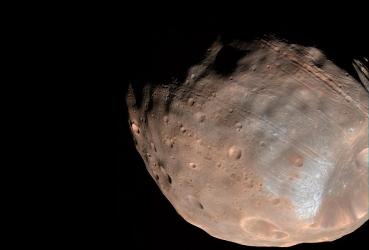
Mars Odyssey orbiter has captured its first images of the ‘Death Star’ moon Phobos–a region that could one day host a human-mission outpost.
Using the Thermal Emission Imaging System (THERMIS) camera, the orbiter has gathered new information on the changing surface temperatures of the Martian moon over the course of a day, revealing how quickly the ground warms and cools.
In stunning new images from the Sept 29 observation, NASA has combined the visible-wavelength and infrared data to show the surface colour-coded by temperature.
ASA has combined the visible-wavelength and infrared data to show the surface colour-coded by temperature.
By reading the photo from left to right, it reveals a sequence of times of day, from pre-dawn through sunrise, and long after dawn, according to NASA.
NASA has combined the visible-wavelength and infrared data to show the surface colour-coded by temperature.
By reading the photo from left to right, it reveals a sequence of times of day, from pre-dawn through sunrise, and long after dawn, according to NASA.
Phobos: Know More- A football-shaped object just 16.5 miles by 13.5 miles by 11 miles, Phobos is one of the smallest moons in the solar system.
- It is so tiny that it would fit comfortably inside the Washington, D.C. Beltway.
- The little moon completes an orbit in just 7 hours and 39 minutes, which is faster than Mars rotates.
- Rising in the Martian west, it runs three laps around the Red Planet in the course of one Martian day, which is about 24 hours and 40 minutes.
- It’s the only natural satellite in the solar system that circles its planet in a time shorter than the parent planet’s day.
- Part of the observed face of Phobos was in pre-dawn darkness, part in morning daylight.
- Including a predawn area in the observation is useful because all the heating from the previous day’s sunshine has reached its minimum there.
- By reading the photo from left to right, it reveals a sequence of times of day, from pre-dawn through sunrise, and long after dawn, according to NASA.
- While other orbiters have taken high-resolution photos of the Martian moon, THEMIS is the first to capture this type of infrared information.
- This can provide information on the mineral composition, as well as the texture, of the surface.
- The texture is related to the ground’s ability to warm up and cool down, the researchers explain.
Scientists are working to understand if Phobos, and the smaller Martian moon Deimos, are captured asteroids or pieces of Mars itself, knocked in space by impacts. - The orbiter gathered new information on the changing surface temperatures of the Martian moon over the course of a day.
- Odyssey’s new observations are the first the craft has captured of Phobos since it began orbiting the Red Planet in 2001.